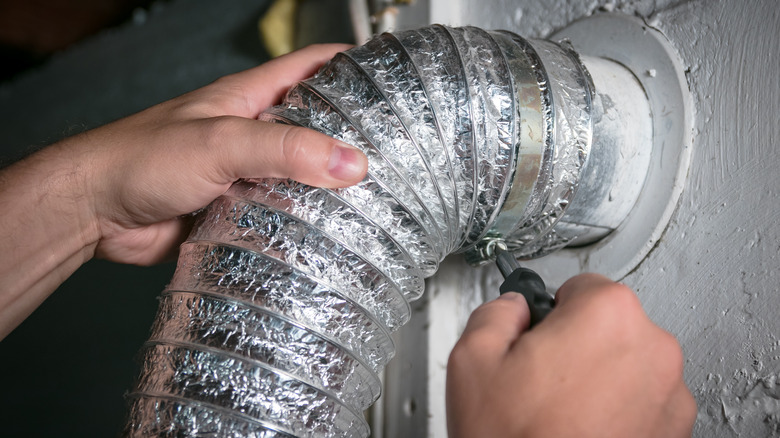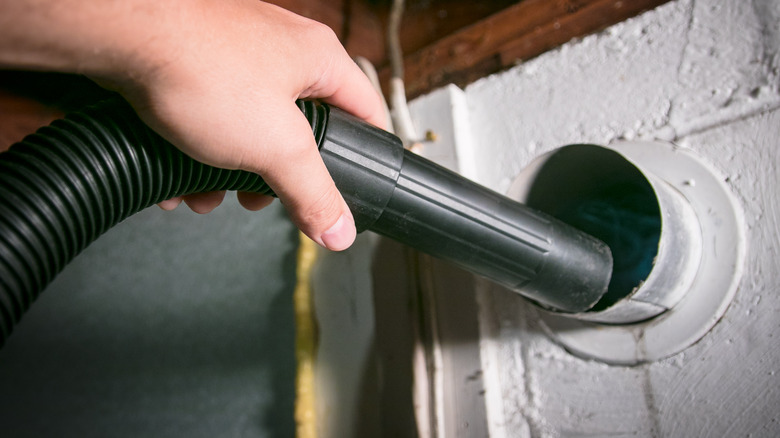How To Choose The Right Type Of Dryer Vent Tubing
Shopping for a new clothes dryer can feel exciting and stressful, and even after you've picked out the perfect appliance, you'll still have some careful thinking to do. The right dryer vent hose needs to be durable and fire-resistant in order to dry clothes efficiently and keep your household safe. Clothes dryers cause nearly 15,000 house fires every year, racking up more than $200 million annually in property damage costs for homeowners (via Envista Forensics). Lint buildup and improper vent material are some of the most common reasons why fires start in clothes dryers, so it's crucial to weigh your dryer hose options carefully.
Some vent options are much pricier than others, and certain types of dryer hoses can be difficult to install by yourself. Choosing the right vent hose isn't just important for safety reasons either; there are actually legal limitations for what you can use to connect your dryer to the wall, how long the dryer hose can be, and where it funnels the lint and steam exhaust. Here are the criteria you need to consider before installing your clothes dryer.
The best and worst dryer vent hoses
While they all serve the same basic purpose, dryer vent hoses come in a variety of materials and price ranges. The most affordable option is generally a plastic or flexible vinyl hose. Vinyl hoses are easy to attach to the dryer and adjust if needed, but they are some of the worst offenders when it comes to lint buildup and accidental fires, and they are banned under many building codes. Aluminum foil and semi-rigid aluminum are the next most affordable options, and they are slightly safer than vinyl while maintaining some flexibility. Aluminum hoses shouldn't be run through walls or long distances, and like vinyl, they have a tendency to trap lint in folds and kinks. These are commonly used for rental homes and apartments, as long as the inner ductwork is safe. Depending on your building code, aluminum hoses may not be legal.
The best dryer hoses are slim ducts and rigid metal vents. These tend to be pricier than vinyl and aluminum, but they are more long-lasting and less prone to lint buildup and potential house fires. A slim duct is ideal for small laundry rooms and closets because it has a narrow, rectangular shape that allows it to keep a low profile behind the dryer. Round and rigid metal ducts, on the other hand, are the best option overall and are the only vent material safe for running through walls.
Proper installation and care
No matter which duct material you opt for, look for a product that is tested and certified and follow all the proper installation steps to reduce the risk of fire. If you choose a flexible vent hose, cut it down to size to avoid bends and kinks, which trap lint. The duct behind the dryer should be no longer than 8 feet, and in-wall ducts should be 35 feet or less. Besides the transition hose that connects the machine to the vent, the actual in-wall ducts should be made of rigid, smooth metal. They should always lead to the outside of the home and never into an attic, chimney, or crawlspace. Lint collecting in these spaces is an obvious hazard, but moisture from the dryer steam can also introduce mold and damage structures over time.
If you're buying a new house, always have a home inspector look at the dryer vent and determine when it was last cleaned. That's right; you should be cleaning your dryer vents and cleaning or replacing the transition ducts at least every one to two years. Due to their heating process, electric dryers tend to produce more lint and cause more fires than gas-powered dryers, so you may need to clear your ducts more frequently if you have an electric unit. Keeping the vent ducts clean is key to making sure the house stays safe and your appliance works efficiently for many years to come.


